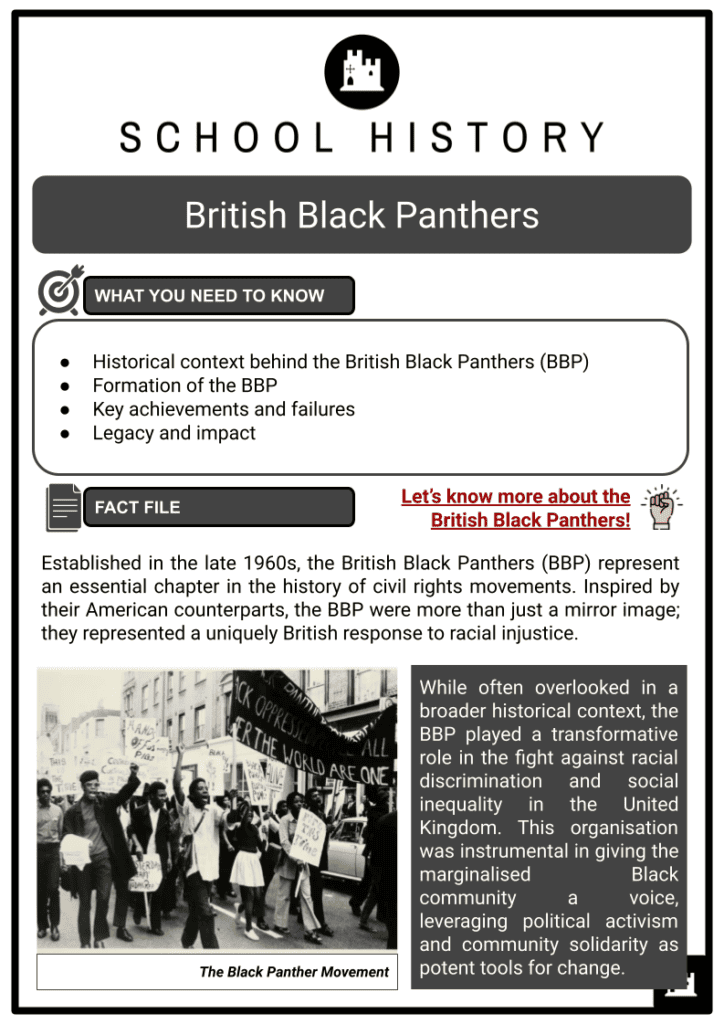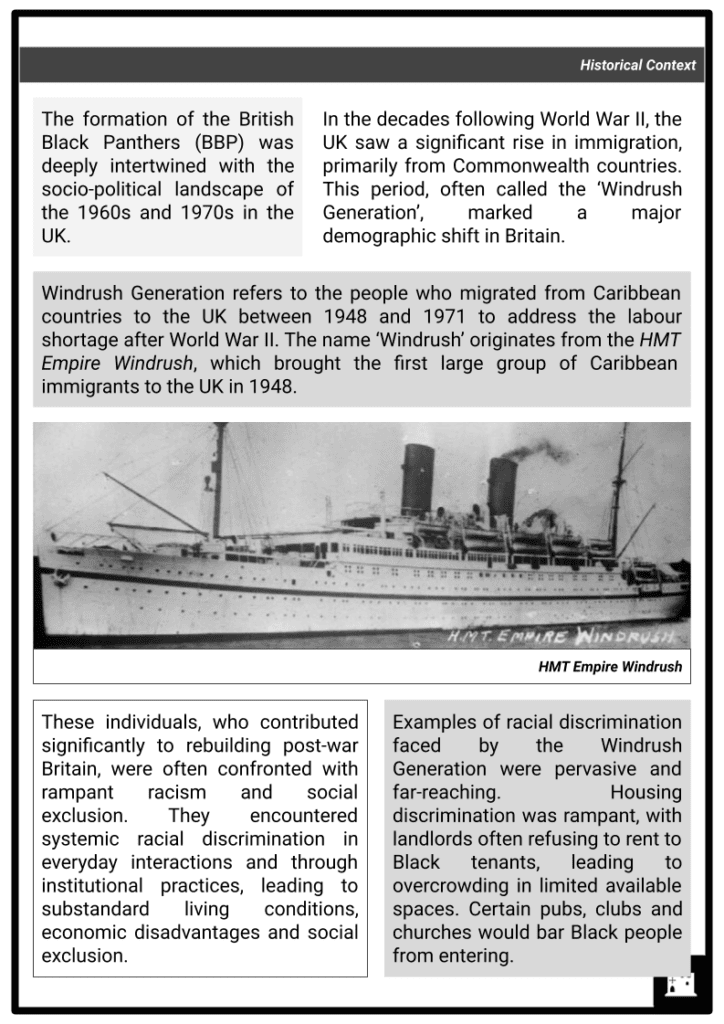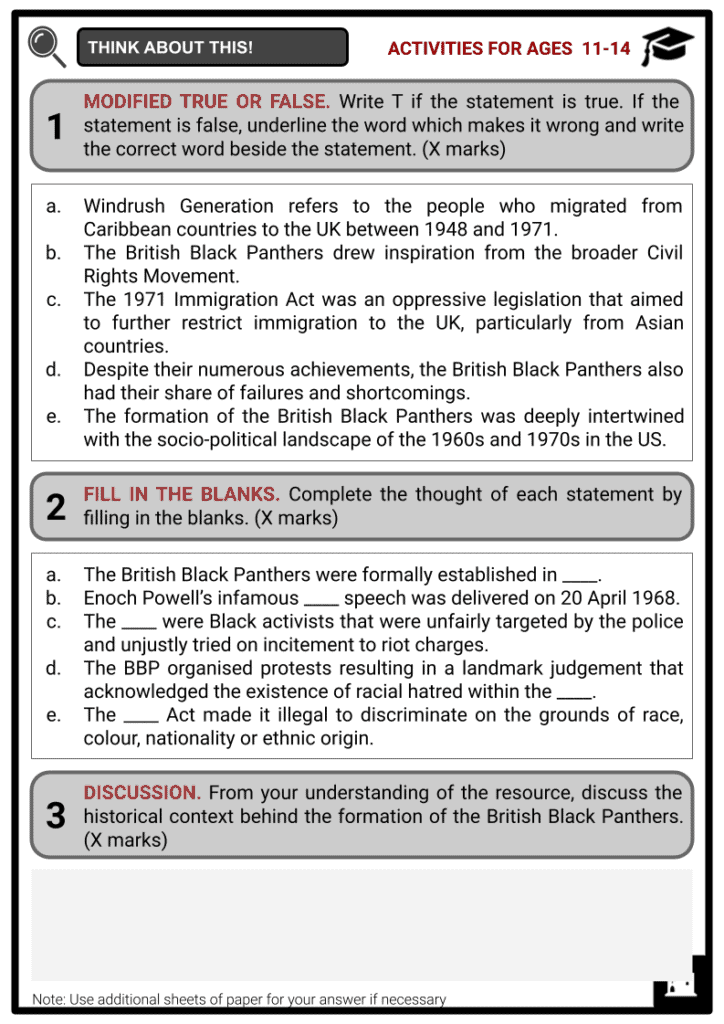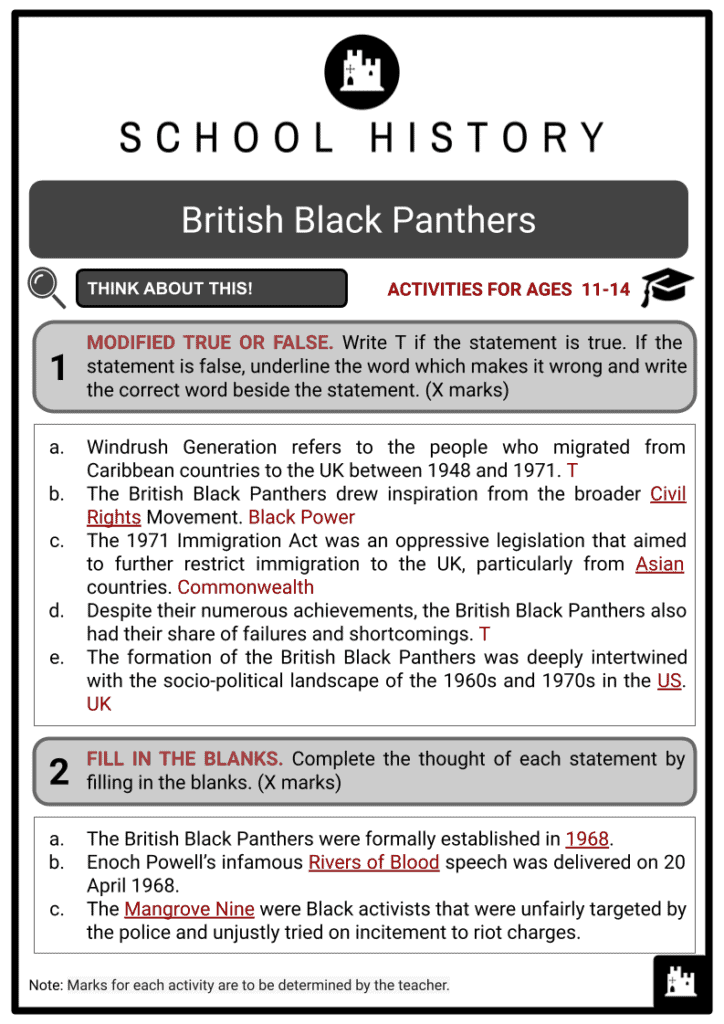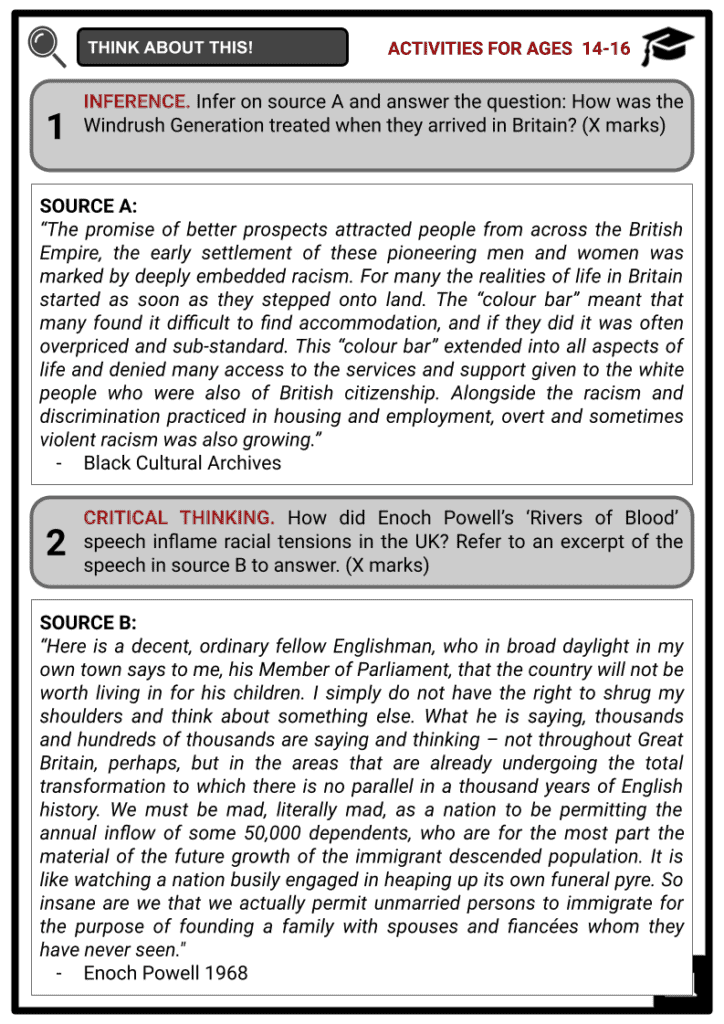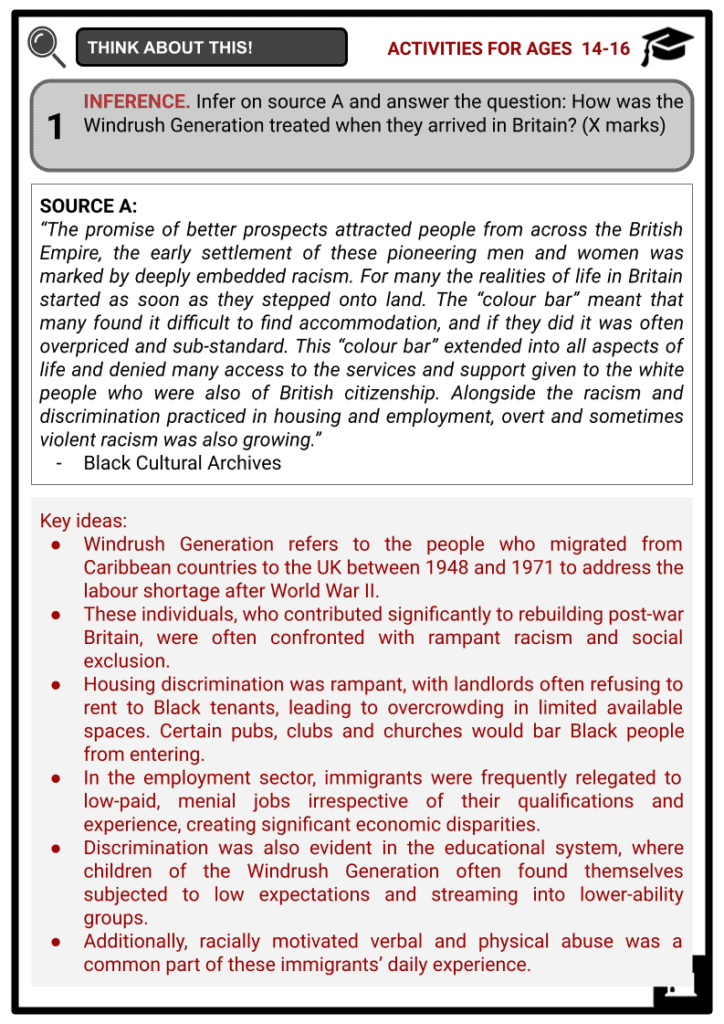British Black Panthers Worksheets
Do you want to save dozens of hours in time? Get your evenings and weekends back? Be able to teach about British Black Panthers to your students?
Our worksheet bundle includes a fact file and printable worksheets and student activities. Perfect for both the classroom and homeschooling!
Summary
- Historical context behind the British Black Panthers (BBP)
- Formation of the BBP
- Key achievements and failures
- Legacy and impact
Key Facts And Information
Let’s know more about the British Black Panthers!
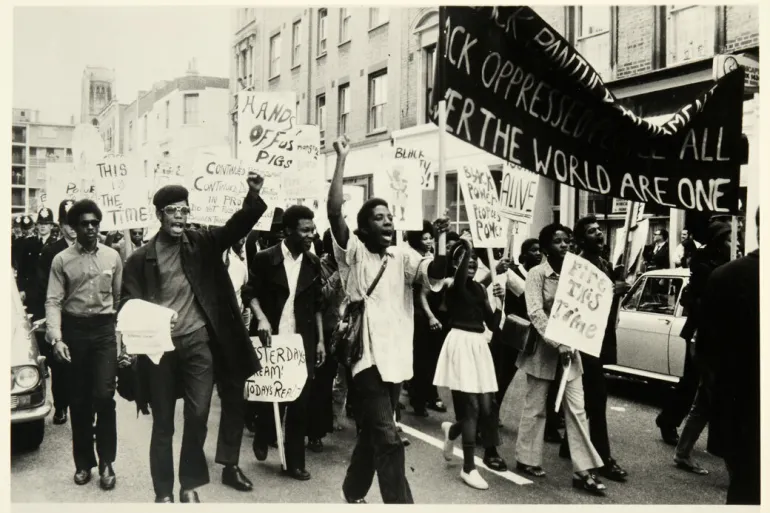
Established in the late 1960s, the British Black Panthers (BBP) represent an essential chapter in the history of civil rights movements. Inspired by their American counterparts, the BBP were more than just a mirror image; they represented a uniquely British response to racial injustice. While often overlooked in a broader historical context, the BBP played a transformative role in the fight against racial discrimination and social inequality in the United Kingdom. This organisation was instrumental in giving the marginalised Black community a voice, leveraging political activism and community solidarity as potent tools for change.
Historical Context
- The formation of the British Black Panthers (BBP) was deeply intertwined with the socio-political landscape of the 1960s and 1970s in the UK. In the decades following World War II, the UK saw a significant rise in immigration, primarily from Commonwealth countries. This period, often called the ‘Windrush Generation’, marked a major demographic shift in Britain.
- Windrush Generation refers to the people who migrated from Caribbean countries to the UK between 1948 and 1971 to address the labour shortage after World War II. The name ‘Windrush’ originates from the HMT Empire Windrush, which brought the first large group of Caribbean immigrants to the UK in 1948.
HMT Empire Windrush
- These individuals, who contributed significantly to rebuilding post-war Britain, were often confronted with rampant racism and social exclusion. They encountered systemic racial discrimination in everyday interactions and through institutional practices, leading to substandard living conditions, economic disadvantages and social exclusion.
- Examples of racial discrimination faced by the Windrush Generation were pervasive and far-reaching. Housing discrimination was rampant, with landlords often refusing to rent to Black tenants, leading to overcrowding in limited available spaces. Certain pubs, clubs and churches would bar Black people from entering.
- In the employment sector, immigrants were frequently relegated to low-paid, menial jobs irrespective of their qualifications and experience, creating significant economic disparities. Discrimination was also evident in the educational system, where children of the Windrush Generation often found themselves subjected to low expectations and streaming into lower-ability groups, which hindered their academic progress and future opportunities.
- Additionally, racially motivated verbal and physical abuse was a common part of these immigrants’ daily experience.
- Despite the hardships they faced, the Windrush Generation laid the groundwork for multicultural Britain. Amid this backdrop, the BBP emerged as a beacon of resistance and empowerment. Drawing lessons from global civil rights movements, they sought to challenge the systemic racism deeply ingrained in British society. The BBP’s activism played a crucial role in catalysing race relations legislation and shaping multicultural Britain as we know it today.
Formation of the British Black Panthers
- The British Black Panthers were formally established in 1968, in the wake of Enoch Powell’s infamous ‘Rivers of Blood’ speech, which inflamed racial tensions in the UK.
- Delivered on 20 April 1968 to the Conservative Association in Birmingham, the speech is notorious in British history for its explicit and incendiary right-wing rhetoric. In it, Powell, then a Conservative MP, warned of the dangers he believed were inherent in the UK’s immigration policy. He portrayed a future in which the native British population would be marginalised and overpowered by immigrants, specifically those of colour.
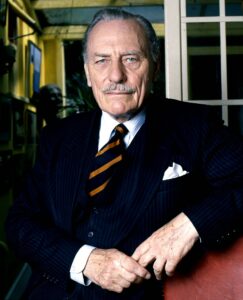
Enoch Powell - Powell quoted a constituent predicting ‘rivers of blood’ due to racial violence, using this phrase to title his speech, making it symbolic of vehement opposition to immigration and multiculturalism.
- The speech’s divisive language and Powell’s influential position amplified racial tensions in the UK. However, it also sparked widespread outrage and mobilised anti-racist activists, including the British Black Panthers, to push for change.
- The BBP’s founding members, including Altheia Jones-LeCointe, Darcus Howe and Farrukh Dhondy, were mainly immigrants from the Caribbean who were deeply affected by the prevalent racial prejudice.
- As students and intellectuals, they drew inspiration from the American Black Panthers and the broader Black Power movement, adopting the iconic black beret as a symbol of their struggle.
- However, the BBP carved out their unique identity, focusing their efforts on combating the direct racial discrimination they faced in Britain. They initiated education programmes, legal aid and housing assistance, and were instrumental in organising protests against police brutality. The formation of the BBP marked a turning point for Black activism within Britain, signalling a new, proactive stance against inequality and injustice.
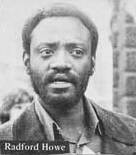
Darcus Howe
Key Achievements
- The British Black Panthers made several significant strides in pursuing racial equality. One of their most notable achievements was the establishment of supplementary schools. They provided Black children with a supportive learning environment where they could learn about Black history and culture, addressing the gaping void left by the mainstream British education system. In terms of legal victories, the BBP played a key role in the defence of what became known as the Mangrove Nine, who were Black activists that were unfairly targeted by the police and unjustly tried on incitement to riot charges.
- The BBP organised protests and provided legal aid, resulting in a landmark judgement that, for the first time, acknowledged the existence of racial hatred within the Metropolitan Police.
- The act abolished the automatic right of Commonwealth citizens to reside in the UK, instead introducing a system that linked immigration rights to employment in the UK, mainly to jobs that were of national importance.
- The British Black Panthers vociferously protested against this racially charged legislation. They saw it as a blatant attempt to curb multiculturalism and diversity and viewed it as a reflection of the British government’s racist underpinnings.
- Their protests against the act were instrumental in raising public awareness about its discriminatory nature and marked another significant step in their ongoing fight for racial equality. Though the act was eventually passed, the debate it sparked led to increased public consciousness about racial discrimination.
- The BBP’s activism also indirectly led to the implementation of the 1976 Race Relations Act, which made it illegal to discriminate on the grounds of race, colour, nationality or ethnic origin. The act represented a pivotal moment in British legislation, marking a significant stride towards racial equality.
- Influenced by the activism of groups like the British Black Panthers, the act extended the previous acts of 1965 and 1968. It outlawed discrimination on the grounds of race, colour, nationality or ethnic origin, not only in public functions but also in private establishments and services.
- These and other achievements underscore the British Black Panthers’ significant role in the fight against racial discrimination in the UK.
Key Failures
- Despite their numerous achievements, the British Black Panthers also had their share of failures and shortcomings.
- Additionally, the organisation struggled with internal disputes and divisions, which ultimately led to its dissolution. The ideological divide between members who advocated for a more aggressive, militant approach and those who favoured peaceful means of protest and negotiation was a significant issue behind its disputes. This discord often resulted in conflicting strategies and a lack of a unified front.
- Moreover, disputes arose from differing views on the intersection of race and class. Some members believed the struggle against racial discrimination should be intertwined with the fight against economic inequality, while others argued that the focus should remain solely on race-related issues. These fundamental disagreements caused friction and eventually contributed to the disbandment of the organisation.
- Lastly, personal feuds and power struggles within the group'’s leadership also led to further fragmentation and instability. As these disputes heightened, the effectiveness of the British Black Panthers as a cohesive force for change diminished, ultimately precipitating their dissolution.
- Perhaps the most significant failure of the BBP was their inability to prevent the passing of the controversial 1971 Immigration Act. Despite their protests and advocacy, the law was enacted, marking a significant setback in their fight against racial discrimination.
Legacy and Impact
- Although it had a brief existence, the BBP made a lasting impact on British culture. The movement not only brought attention to racial injustices but also empowered Black Britons to assert their rights and identity.
- The BBP’s impact far outlived the organisation itself, shaping the landscape of racial activism and ushering in a new era of self-awareness among Black Britons. The organisation’s initiatives in education were particularly influential, with their supplementary schools serving as a blueprint for future educational programmes aimed at addressing racial disparities.
- Furthermore, the BBP’s commitment to community services, such as the breakfast programme for children, set a precedent for the necessity of community care in activism. Subsequent generations of racial equality advocates have carried forward this ethos of community service.
- The BBP also played a crucial role in amplifying the voices of Black women within the race and gender equality movements. Their insistence on egalitarianism within their ranks challenged the male-dominated narrative prevalent in many activist circles of the time, a contribution that is still lauded today.
- In the realm of arts and culture, the BBP inspired a wealth of Black British literature, music and visual arts. Their influence can be seen in works that explore themes of racial identity and resistance, reflecting the BBP’s enduring impact on the cultural consciousness of Black Britain.
- Despite the challenges and eventual disbandment, the legacy of the British Black Panthers is one of resilience, resistance and empowerment. They confronted racial inequality head-on and fostered a sense of community and identity that would inspire and influence generations to come. Today, the legacy of the BBP continues to inspire activists fighting for racial equality.
Image Sources
- https://www.aljazeera.com/wp-content/uploads/2020/12/24284955104_1122f88183_o.jpg?resize=770%2C513&quality=80
- https://upload.wikimedia.org/wikipedia/commons/thumb/6/61/Enoch_Powell_6_Allan_Warren.jpg/800px-Enoch_Powell_6_Allan_Warren.jpg
- https://upload.wikimedia.org/wikipedia/commons/4/44/Battle_for_Freedom_at_the_Old_Bailey_poster_%2824819736411%29_%28cropped22%29.jpg
Frequently Asked Questions
- What were the British Black Panthers?
The British Black Panthers were a political and civil rights movement that emerged in the late 1960s and early 1970s in the United Kingdom. They sought to address racial inequality, police brutality, and social injustice.
- What were the main goals of the British Black Panthers?
The British Black Panthers aimed to combat racial discrimination, advocate for civil rights, and highlight systemic Black community issues, including police mistreatment.
- Did the British Black Panthers achieve their goals?
While the British Black Panthers did not achieve all their goals, they raised awareness about racial inequality and contributed to the broader civil rights movement in the UK.

